Adapters for Zeiss Axioskop and Examiner Microscopes
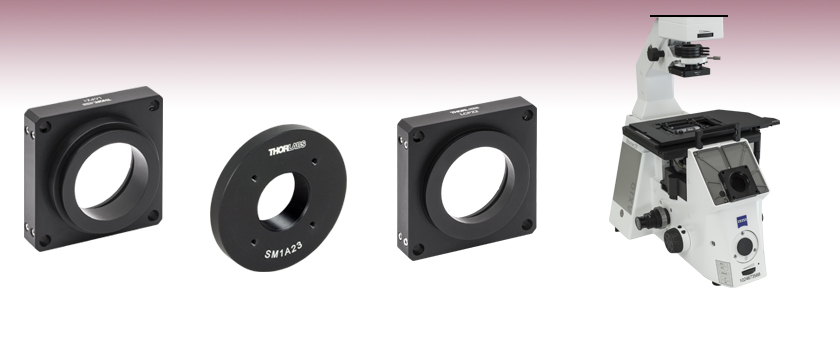
- Lamphouse, Trinocular, Eyepiece, and Condenser Port Adapters
- Integrate Thorlabs' Mechanical Components with Zeiss Axioskop and Examiner Microscopes
LCPZ1
Condenser Port Adapter
SM1A23
Lamphouse Port Adapter
LCPZ2
Trinocular Port Adapter
LCPZ1 and LCPZ2 Adapters Attached to Zeiss Axio Observer Microscope

Please Wait
Click on Each Port to View Available Adapters
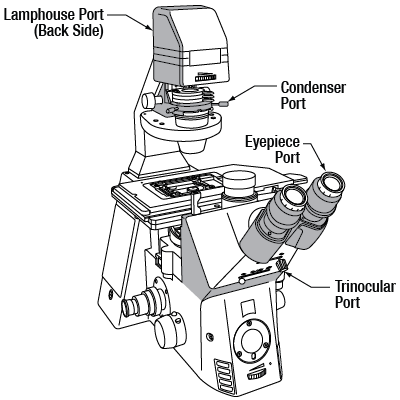
Zeiss Axio Observer Microscope
Features
- Extends Versatility of Thorlabs' Construction Systems to Zeiss Axioskop and Examiner Microscopes
- Provides Compatibility with SM1 Lens Tubes, SM2 Lens Tubes, and 30 mm and 60 mm Cage Systems
- Designed for Lamphouse, Trinocular, Eyepiece, and Condenser Ports
- Contact Tech Support about Custom Adapters, Including for Other Microscopes
Lamphouse Port Adapters
These adapters provide compatibility between Zeiss Axioskop and Examiner microscope lamphouse ports and our SM1 (Ø1") lens tubes, 30 mm cage assemblies, or SM2 (Ø2") lens tubes.
Trinocular Adapters
The LCPZ2 adapter is designed for the trinocular port of a Zeiss Axioskop microscope, providing a secure connection for custom widefield viewing and image detection setups.
The SM2Z1 adapter replaces the lens element on an eyepiece of the trinoculars, allowing custom image detection or viewing setups to be attached to the microscope.
Condenser Adapter
The LCPZ1 adapter connects to the condenser holder of a Zeiss Axioskop microscope, allowing the attachment of DIY setups that condition incoming light for trans-illumination.
Note: Thorlabs does not guarantee compatibility with other industry-standard microscopes not explicitly mentioned on this webpage.
| Adapters for Industry Standard Microscopes |
|---|
| Cerna DIY Series |
| Leica DMI |
| Nikon Eclipse Ti (Inverted) |
| Nikon Eclipse Ti2 (Inverted) |
| Upright Nikon Eclipse |
| Olympus BX and IX |
| Zeiss Axioskop and Examiner |
| Thorlabs Dovetail Referencea | |||
|---|---|---|---|
| Type | Shape | Outer Dimension | Angle |
| 95 mm | Linear | 95 mm | 45° |
| D1N | Circular | Ø2.018" | 60° |
| D2Nb | Circular | Ø1.50" | 90° |
| D2NBb | Circular | Ø1.50" | 90° |
| D3N | Circular | Ø45 mm | 70° |
| D5N | Circular | Ø1.58" | 90° |
| D6N | Circular | Ø1.90" | 90° |
| D7N | Circular | Ø2.05" | 90° |
| D1T | Circular | Ø1.50" | 60° |
| D3T | Circular | Ø1.65" | 90° |
| D1Y | Circular | Ø107 mm | 60° |
| D2Y | Circular | Ø2.32" | 50° |
| D3Y | Circular | Ø1.75" | 90° |
| D4Y | Circular | Ø56 mm | 60° |
| D5Y | Circular | Ø46 mm | 60° |
| D6Y | Circular | Ø41.9 mm | 45° |
| D1Z | Circular | Ø54 mm | 60° |
| D2Z | Circular | Ø57 mm | 60° |
| D3Z | Circular | Ø54 mm | 45° |
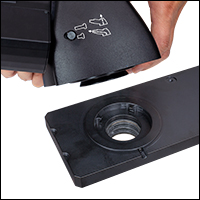
Click to Enlarge
This photo shows the male D1N dovetail on the trinoculars next to the female D1N dovetail on the epi-illumination arm.
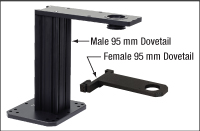
Click to Enlarge
This photo shows the male 95 mm dovetail on the microscope body and the female 95 mm dovetail on the CSA1002 Fixed Arm.
Introduction to Microscope Dovetails
Dovetails are used for mechanical mating and optical port alignment of microscope components. Components are connected by inserting one dovetail into another, then tightening one or more locking setscrews on the female dovetail. Dovetails come in two shapes: linear and circular. Linear dovetails allow the mating components to slide before being locked down, providing flexible positioning options while limiting unneeded degrees of freedom. Circular dovetails align optical ports on different components, maintaining a single optical axis with minimal user intervention.
Thorlabs manufactures many components which use dovetails to mate with our own components or those of other manufacturers. To make it easier to identify dovetail compatibility, we have developed a set of dovetail designations. The naming convention of these designations is used only by Thorlabs and not other microscope manufacturers. The table to the right lists all the dovetails Thorlabs makes, along with their key dimensions.
In the case of Thorlabs’ Cerna® microscopes, different dovetail types are used on different sections of the microscope to ensure that only compatible components can be mated. For example, our WFA2002 Epi-Illuminator Module has a male D1N dovetail that mates with the female D1N dovetail on the microscope body's epi-illumination arm, while the CSS2001 XY Microscopy Stage has a female D1Y dovetail that mates with the male D1Y dovetail on the CSA1051 Mounting Arm.
To learn which dovetail type(s) are on a particular component, consult its mechanical drawing, available by clicking on the red Docs icon (![]() ) below. For adapters with a female dovetail, the drawing also indicates the size of the hex key needed for the locking setscrew(s). It is important to note that mechanical compatibility does not ensure optical compatibility. Information on optical compatibility is available from Thorlabs' web presentations.
) below. For adapters with a female dovetail, the drawing also indicates the size of the hex key needed for the locking setscrew(s). It is important to note that mechanical compatibility does not ensure optical compatibility. Information on optical compatibility is available from Thorlabs' web presentations.
For customers interested in machining their own dovetails, the table to the right gives the outer diameter and angle (as defined by the drawings below) of each Thorlabs dovetail designation. However, the dovetail's height must be determined by the user, and for circular dovetails, the user must also determine the inner diameter and bore diameter. These quantities can vary for dovetails of the same type. One can use the intended mating part to verify compatibility.
In order to reduce wear and simplify connections, dovetails are often machined with chamfers, recesses, and other mechanical features. Some examples of these variations are shown by the drawings below.

Click to Enlarge
Two examples of how circular male dovetails can be manufactured.

Click to Enlarge
Two examples of how circular female dovetails can be manufactured.
| Posted Comments: | |
david naranjo
(posted 2021-12-31 10:16:46.007) hello
I need to replace a SM1A23 with spmething equivalent for the old Zeiss bayonet (I believe is 44 mm) cdolbashian
(posted 2022-01-14 02:27:49.0) Thank you for reaching out to us with your inquiry David. After reviewing the various options we carry for Zeiss adapters on our product page, I have concluded that we do not carry and adapter for a 44mm bayonet. For other Zeiss adapters, please feel free to look at our offerings here: https://www.thorlabs.com/newgrouppage9.cfm?objectgroup_id=8739&pn=SM1A23 |

These adapters allow a collimated trans-illumination source to be attached to the lamphouse port of a Zeiss Axioskop or Examiner microscope. For instance, the LED4A4 and SM2A16 are directly compatible with Thorlabs' Solis® LEDs. Each adapter uses a male D3Z dovetail to connect to the port. They are offered with either black or silver anodization to match the surface finish of various devices, such as our 4-Wavelength LED Source. See the table below for adapter compatibility with Thorlabs’ SM thread and cage system standards.
Note: Thorlabs does not guarantee compatibility with other industry-standard microscopes not explicitly mentioned on this webpage.

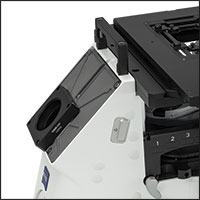
Click to Enlarge
SM2Z1 Adapter Attached to Exposed Trinocular Port
The LCPZ2 Trinocular Port Adapter allows custom widefield viewing setups to be attached to a Zeiss Axioskop microscope. This adapter utilizes a male D2Z dovetail adapter to connect to the trinocular port of the microscope; see the Microscope Dovetails tab for details. This adapter can only be attached by first removing the microscope's trinoculars (see image to the right).
This adapter features internal SM2 threading for Ø2" lens tubes; one SM2RR retaining ring is included to secure a Ø2" flat optic up to 0.3" (7.6 mm) thick against the internal lip of the adapter. The adapter lip limits the clear aperture to Ø1.58". Through holes with side-located locking 8-32 setscrews (5/64" [2 mm] hex) can be used to attach Ø6 mm cage rods for 60 mm cage systems.
Note: Thorlabs does not guarantee compatibility with other industry-standard microscopes not explicitly mentioned on this webpage.

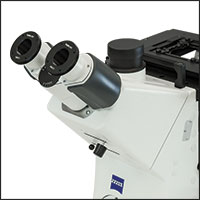
Click to Enlarge
Two SM2Z1 adapters replace the lens elements of the trinocular eyepieces.
The SM2Z1 Eyepiece Port Adapter allows custom-built optical detection systems to attach to the eyepieces on the trinoculars of a Zeiss Axioskop or Examiner Microscope. This adapter replaces the lens element on the eyepiece that sets the image plane focus at the the back of the eyes (see image to the right). Because of the drop-in nature of the adapter, take care the attached system does not overbalance the 40 g eyepiece adapter when it is inside the trinoculars.
This adapter features 1.33" (33.7 mm) of internal SM1 threading for Ø1" lens tubes or optics, external SM2 threading for Ø2" lens tubes, and 4-40 tapped through holes on 30 mm centers for compatibility with a 30 mm cage system. The adapter includes two 0.08” thick SM1RR retaining rings to secure an optic inside the adapter.
Note: Thorlabs does not guarantee compatibility with other industry-standard microscopes not explicitly mentioned on this webpage.

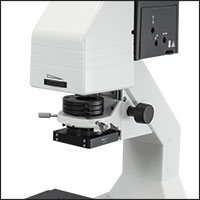
Click to Enlarge
SM2Z1 Adapter Attached to Condenser Holder of Zeiss Axio Observer
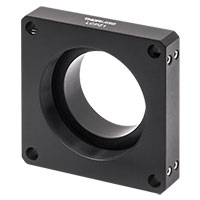
Click to Enlarge
One side of the LCPZ1 adapter has internal SM2 threads.
The LCPZ1 Condenser Port Adapter allows custom condenser configurations to be attached to a Zeiss Axioskop microscope. The adapter utilizes a male D1Z dovetail to connect to the condenser holder of the microscope; see the Microscope Dovetails tab for details.
This adapter features internal SM2 threads for Ø2" lens tubes, achromatic doublets, or other optics; one SM2RR retaining ring is included to secure a Ø2" flat optic up to 0.3" (7.6 mm) thick against the internal lip of the adapter, such as a filter or iris. The adapter lip limits the clear aperture to Ø1.58". Through holes with side-located locking 8-32 setscrews (5/64" [2 mm] hex) can be used to attach Ø6 mm cage rods for 60 mm cage systems.
Note: Thorlabs does not guarantee compatibility with other industry-standard microscopes not explicitly mentioned on this webpage.
 Products Home
Products Home


















 Zeiss Axioskop / Examiner Microscope Port Adapters
Zeiss Axioskop / Examiner Microscope Port Adapters